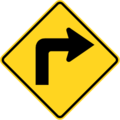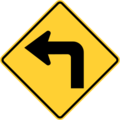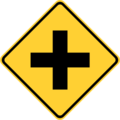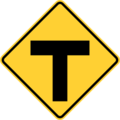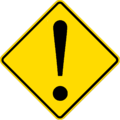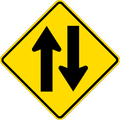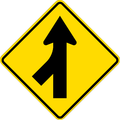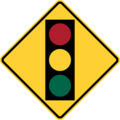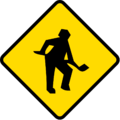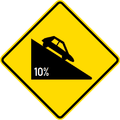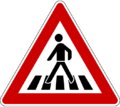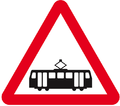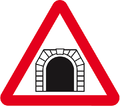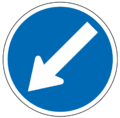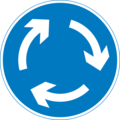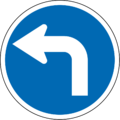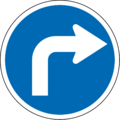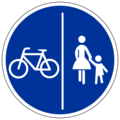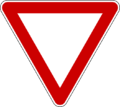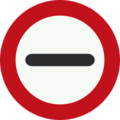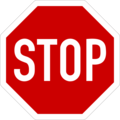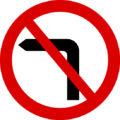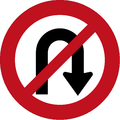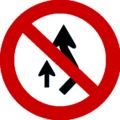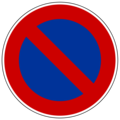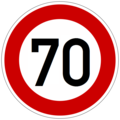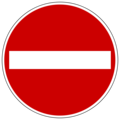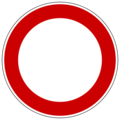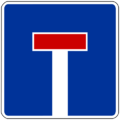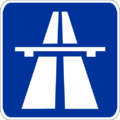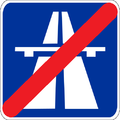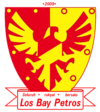Road signs in Los Bay Petros
Road signs in Los Bay Petros standards were adopted from various road standards such as MUTCD, German standards, and Vienna Convention on Road Signs and Signals standards. Although a number of changes over the years have introduced some slight deviations that suit local road conditions (such as fonts). Road signs in Los Bay Petros conform to the local Traffic and Driving code under authority of the CPA-CTP.
Los Bay Petrosian signs depict classical silhouetted persons.
Warning signs
Warning signs warn of possible dangers or unusual conditions ahead and alert motorists on the hazards to expect. They are similar to the United States design, in that they are black on an amber (orangish yellow) background, and are diamond shaped.
-
Sharp bend
-
Sharp curve (right)
-
Sharp curve (left)
-
Double curve
-
Series of bends
-
4 way junction
-
T junction
-
Danger ahead
-
Two-way traffic
-
Merge
-
Traffic light ahead
-
Roadwork ahead
-
School
-
Falling rocks
-
Slippery roads
-
Steep hill
There is also some of the Los Bay Petrosian standards uses the European triangles with a red border signs.
-
Pedestrian crossing ahead
-
Tram crossing
-
Tunnel ahead
-
Railway crossing
-
Chevron bend sign
Regulatory signs
Regulatory signs either give positive instructions, i.e. Mandatory signs, or indicate a prohibition, i.e. Prohibitionary signs. Many regulatory signs are accompanied by supplementary plates that provides interdependent exceptions to the rule, or indicates additional instruction or information to facilitate understanding of the rule implemented.
Mandatory signs
Mandatory signs are generally circular with a white border and symbol on a blue background. They usually indicate something all drivers must do (e.g. keep left) or a facility available to certain classes of traffic (e.g. pedal cycles only).
-
Go straight
-
Keep left
-
Roundabout
-
Turn left
-
Turn right
-
Shared path
The exceptions are the octagonal red STOP sign, the triangular GIVE WAY sign and the various mandatory STOP signs that are circular and have a red border.
-
Give way
-
Stop for check
-
Stop
Prohibitionary signs
Prohibitory signs, which generally tell drivers what they must not do, are mostly circular and have a red border. The red ring indicates the prohibition; diagonal bars are used only on signs which prohibit a specific manoeuvre, i.e. banned left or right turns and U-turns, or a certain class of vehicle, i.e. lorries.
-
No left turn
-
No right turn
-
No u-turn
-
No overtaking
-
No parking
-
No parking (Alternate)
-
No waiting or stopping
-
Speed limit (usually on National Routes)
-
Speed limit (usually on Autoroutes
-
Width limit
-
Height limit
-
No entry
-
No vehicles
Information signs
Information signs are signs that may be mounted to indicate a certain condition or nature of the road ahead that motorists need to take note. They are independent of existing mandatory and prohibitive signs. Such signs are usually white or blue and rectangular in shape.
-
Parking
-
One way
-
Dead end
-
Autoroute starts
-
Autoroute ends
-
Turn left
(without using traffic lights) -
Turn left
(No turn left if traffic light on red) -
Milestone
-
Speed camera
Directional signs
- Signs indicating destinations reached via autoroutes have white lettering on a blue background.
- Signs indicating destinations reached via other roads have white lettering on a green background.
- Signs indicating local destinations have black lettering on a white background.
- Signs indicating recreational facilities and landmarks have white lettering on a brown background.
Roads
-
Road name
-
At the junction
-
Intersection
-
Intersection (On National Routes)
-
Distance sign (On National Routes)
-
Roundabout intersection
-
Intersection (Alternate)
-
Intersection (Alternate)/Dual carriageway
Autoroute
-
Autoroute sign
-
Autoroute entry sign (at a junction)
-
Autoroute entry sign
-
Entrance for ePay users only
-
No hitchiking
-
Toll plaza 1 km ahead
-
Toll plaza 500m ahead
-
ePay user lanes (on toll plaza)
-
e-toll user lanes (on toll plaza)
-
Exit (1000m)
-
Exit (500m)
-
Exit (Take next left)
-
Exit to another Autoroute (2000m)
-
Exit to another Autoroute (1000m)
-
Exit to another Autoroute (500m)

